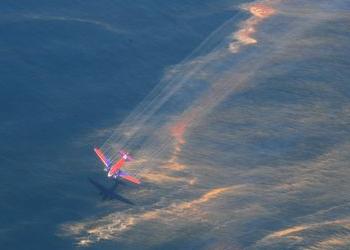
SAN FRANCISCO, California, May 30, 2013 (ENS) – The federal government must analyze the effects of the California Dispersants Plan to determine whether the chemicals that break up oil spills would harm endangered wildlife, under a legal settlement filed today by federal agencies and conservation groups.
Finalized in 2008, the California Dispersants Plan authorizes the use of chemical dispersants in the event of an oil spill in California federal offshore waters.
Three conservation groups sued the federal government to force determination of the dispersants’ safety for endangered species before the chemicals are used to break down spilled oil, not afterwards, as occurred during 2010 BP Deepwater Horizon oil spill in the Gulf of Mexico.

“We shouldn’t add insult to injury after an oil spill by using dispersants that put wildlife and people at risk,” said Deirdre McDonnell of the Center for Biological Diversity, which brought suit with Surfrider Foundation and Pacific Environment.
“During the BP oil spill, no one knew what the long-term effects of chemical dispersants would be, and we’re still learning about their harm to fish and corals, McDonnell said.
“People can avoid the ocean after an oil spill, but marine animals can’t. They’re forced to eat, breathe and swim in the chemicals we put in the water, whether it’s oil or dispersants,” she said.
The settlement, filed in the U.S. District Court for the Northern District of California, states that on or before January 31, 2014, the U.S. Environmental Protection Agency and the U.S. Coast Guard must make a written request to the National Marine Fisheries Service and the Fish and Wildlife Service for consultation on the effects of dispersants on endangered species.
The U.S. Endangered Species Act requires the EPA and Coast Guard to consult with the Fisheries Service and Fish and Wildlife Service regarding any activities that might affect endangered wildlife.
Dispersants are chemicals used to break oil spills into tiny droplets. In theory, this allows the oil to be eaten by microorganisms and become diluted faster than if left untreated.
However, say the plaintiff groups, dispersants and dispersed oil can also allow toxins to accumulate in the marine food web.
The settlement covers the four dispersants that are preauthorized for use under the California Dispersants Plan: COREXIT 9527A, COREXIT 9500A, NOKOMIS 3-AA, and NOKOMIS 3-F4. COREXIT 9500A was used during the three months of the BP Deepwater Horizon oil spill April 20 through July 19, 2010.
The settlement requires the federal agencies to consider as part of their analysis six named scientific studies of the effects of dispersants in the BP Deepwater Horizon spill.
One of the six studies found that COREXIT increases the toxicity of oil by 52 times.
“Dispersants are preapproved to help clean up oil spills and are widely used during disasters. But we have a poor understanding of their toxicity. Our study indicates the increase in toxicity may have been greatly underestimated following the Macondo well explosion,” said Roberto-Rico Martinez of Mexico’s Universidad Autonoma de Aguascalientes, who led the study, published in the February 2013 issue of the journal “Environmental Pollution.”
Martinez performed the research while he was a Fulbright Fellow at Georgia Tech in the lab of School of Biology Chairman Professor Terry Snell.
“What remains to be determined is whether the benefits of dispersing the oil by using Corexit are outweighed by the substantial increase in toxicity of the mixture,” said Snell. “Perhaps we should allow the oil to naturally disperse. It might take longer, but it would have less toxic impact on marine ecosystems.”
The plaintiff groups point to other studies finding that oil broken up by the dispersant COREXIT 9527 damages the insulating properties of seabird feathers more than untreated oil, making the birds more susceptible to hypothermia and death.
Studies also have found that dispersed oil is toxic to fish eggs, larvae and adults, as well as to corals, and can harm sea turtles’ ability to breathe and digest food.
The California Dispersants Plan does not guarantee that the dispersant chemicals will be safe for wildlife.
The Plan states, “Pre-approval dispersant zone recommendations do not presume the absence of sensitive species, other marine species, or impacts to species on the water surface or in the upper water column. It does presume that there will be impacts from the spilled oil, and from dispersant use, to some of those species. However, based on the natural resource information used in the planning stage, it was determined that there could be a net environmental benefit to the use of dispersants.”
“The Pacific Ocean encompasses some of the most unique marine ecosystems in the world, providing habitat for many endangered and threatened species,” said Kevin Harun, Arctic program director for Pacific Environment. “The government needs to take the precautionary approach in order to prevent future harm to the health of the environment and people.”
Surfrider Foundation’s Legal Director Angela Howe said,“These chemical dispersants are dangerous to human health in addition to wildlife, and shouldn’t be allowed to threaten a family’s enjoyment of the beach. Surfrider Foundation members in Florida are so concerned about the after effects of the BP spill, they have taken it upon themselves to test the Gulf sand and coastal waters, and have found likely traces of COREXIT attached to undissolved tar product in the coastal zone.”
Copyright Environment News Service (ENS) 2013. All rights reserved.
